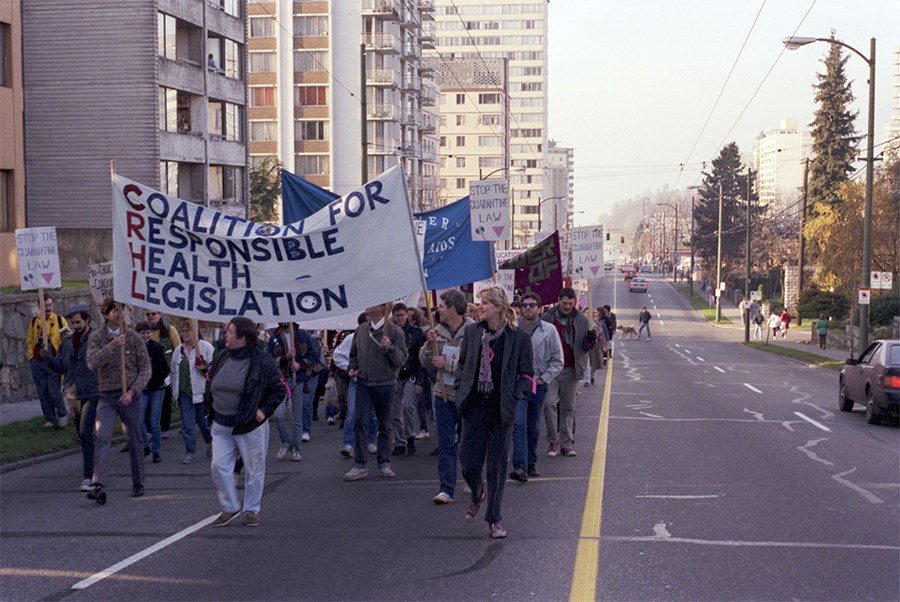Stop me if this sounds familiar: about two-and-a-half decades Vancouver was in the midst of an overdose crisis. The number of people dying in the city at that time peaked at more than 200 people a year. Most of those were in the Downtown Eastside.
At the same time, HIV rates in the city were skyrocketing, the highest in the Western world. Scientists said that Vancouver’s Downtown Eastside neighbourhood had the highest rate of HIV/AIDS infections outside of Sub-Saharan Africa.
It was around this same time, in 1993, that I was first living in the neighbourhood. It was my own drug use – and the need to escape from the trauma I’d experienced at home – that brought me there. Overdoses were happening all around me and people were scared of AIDS. We were just beginning to really understand the connection between injection drug use and HIV infection. It was terrifying for everyone.
Then, as now, drug users were the most impacted by these interesting public health crises. Then, just like now, it was the fear of infection spreading to the wider community that mobilized public health.
First, it was needle exchanges, which were already being operated by community activists before being adopted, in a very limited way, by health officials. Then it was medications, pushed out through street nurses. Finally, it was Insite, a supervised injection site whose opening was the result of years of advocacy by drug users.
The collective impact on HIV infections was monumental. New infections steadily declined. By 2019, the end of the AIDS epidemic was declared in BC. Policy changes coupled with Investments in health services had shifted the tide.
Overdoses, though, have never really gone away. Overdose deaths remained steady through the 1990s and 2000s, around 200-300 every year in BC. Despite its impact on reducing overdose deaths, there was no second Insite in the city or province.
Finally, in 2016, health officials officially declared overdoses a public health emergency. The rise in deaths from 369 in 2014 to 529 in 2015 to 991 in 2016 became too much to ignore.
But the truth is, the overdose public health emergency started back in the 1990s and never ended. The conditions and policies that have made the drug supply so toxic and risk of a drug poisoning so high have always been there. Unlike with HIV/AIDS, there have been no big policy changes.
We’ve always known what policy changes are needed to keep people who use drugs safe. Drug users and others have repeatedly called for decriminalization and a regulated drug supply. We’re hearing a lot about these types of approaches now, but they’re not new ideas. They’ve simply never been implemented, and today we’re seeing the devastating and deadly results.
For people who use drugs and for their families, witnessing the full-weight of policy and public health mobilized to stop the pandemic spread is difficult. With COVID-19, we’re seeing history repeat itself. Two public health crises at the same time, but only one met with the full weight of a coordinated response. Two public health crises and people who use drugs viewed, and treated, as though they are vectors of disease.
Country-wide lockdowns to limit infection and vaccines developed and delivered inside of a year show what we can do when we act. Ongoing fatal drug poisonings show what happens when we do nothing.
Unlike with COVID-19, there has been no coordinated and targeted response to overdoses. Someone overdoses and we hope that someone is there to reverse it. That’s the best we’ve done.
Every day government officials publicly acknowledge those who’ve died of COVID-19. They share their grief over the loss and send thoughts out to families. Nobody acknowledges the loss of life to overdose unless they’re compelled to by the release of some new report. And no one apologies to the families and communities who’ve suffered such loss.
What’s stayed the same from the 1990s and 2020s is that stigma towards people who use drugs has always been there. The policies that marginalize people and put them at risk are still in place.
What hasn’t changed is that some people’s lives matter more than others, as the response to these public health responses makes very clear.



